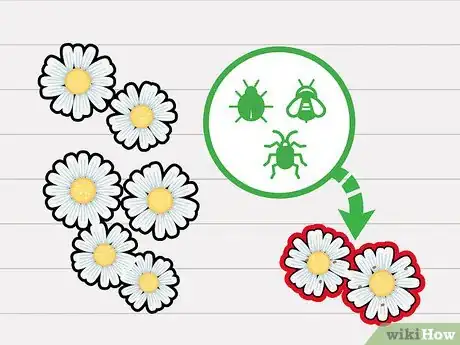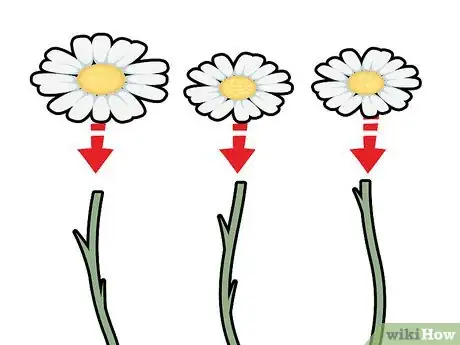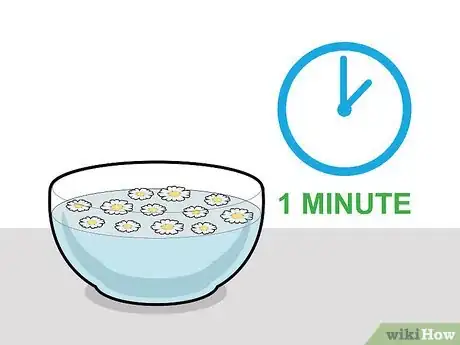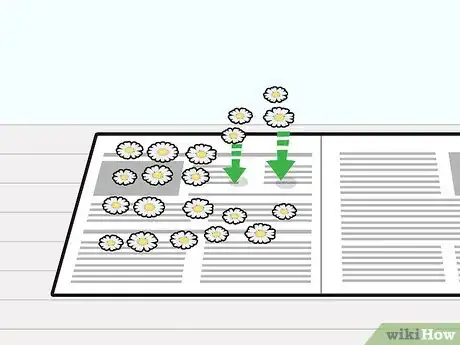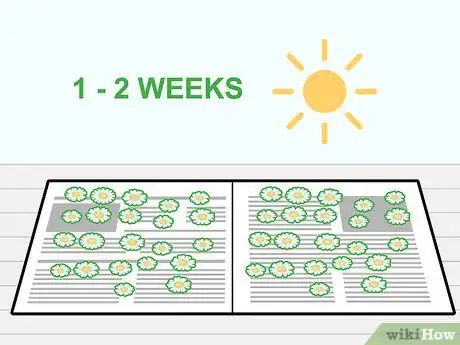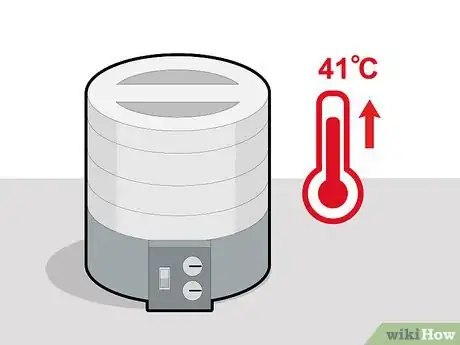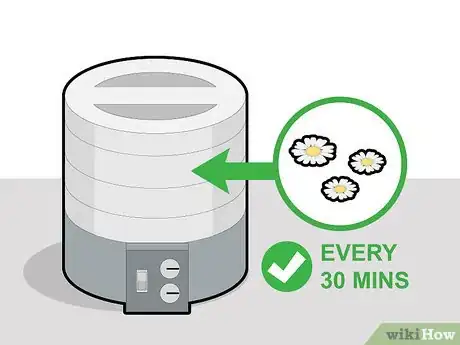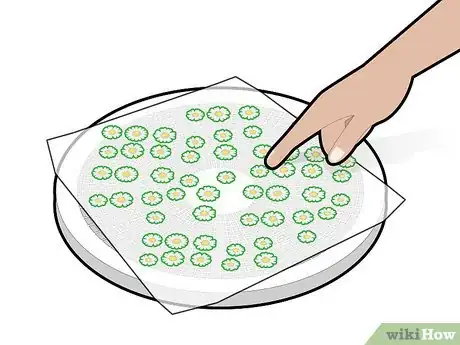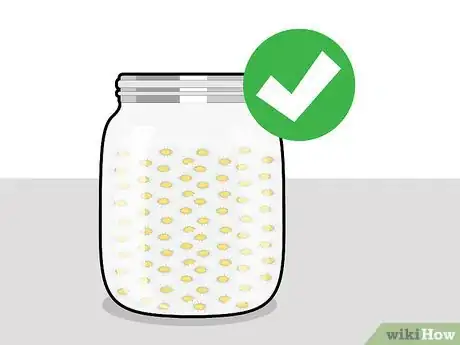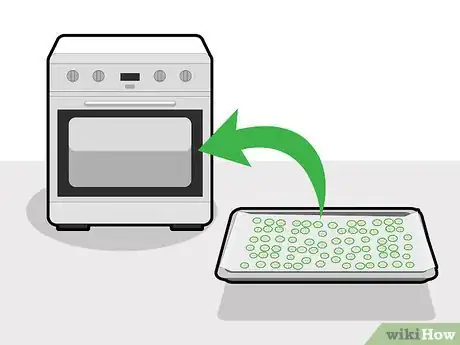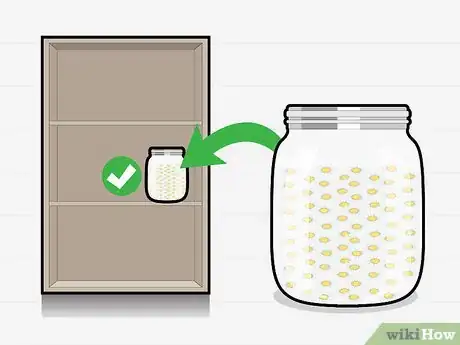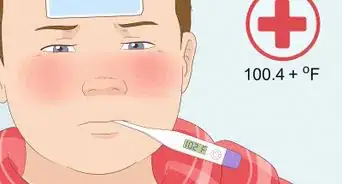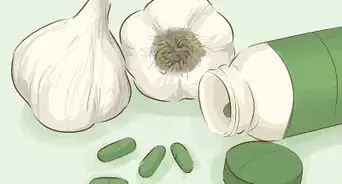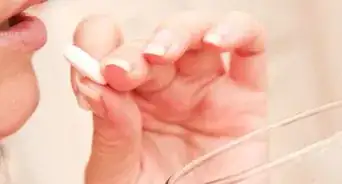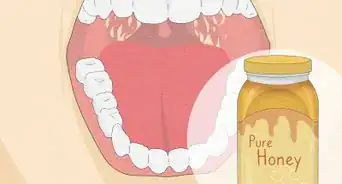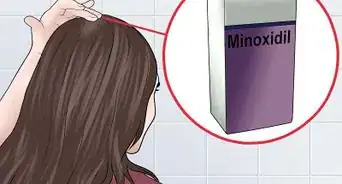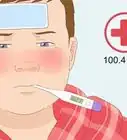This article was co-authored by Erica Docimo, L.Ac., Dipl. O.M.. Erica Docimo is a California and National Certification Commission for Acupuncture and Oriental Medicine (NCCAOM) Licensed Acupuncturist, Herbalist, and the Owner of Mind and Body Acupuncture, a holistic healthcare and lifestyle studio based in Los Angeles, California. With over 15 years of experience, she specializes in Acupuncture, Herbal Prescriptions, and Eastern and Western Nutrition. Erica holds a Masters of Chinese Medicine from The Emperor’s College with a focus on Women’s Health. She also received training at The Academy of Orthopedic Acupuncture (AOA) to become certified in pain reflex-release technique and manual nerve blocking.
This article has been viewed 18,236 times.
Dried chamomile flowers have many uses and health benefits. They can be made into soothing teas, skin-relief creams, and added to recipes for their flavor. Maybe you just picked some chamomile flowers from your garden, or you came back from the farmer's market with a fresh bunch. But many recipes for chamomile concoctions call for dried flowers, not fresh. Not to worry; there are a few ways you can dry it yourself at home! Once you've dried your chamomile, it'll be ready for the project of your choice, whether that's tea, cooking, medicine, cosmetics, decoration, or a nice aromatic bath.
Steps
Sun-Drying Chamomile
-
1
-
2Remove the stems if you want to. Unless you like the way they look, there isn't much purpose in keeping the whole stem.[3] The head of the flower is what contains its healing properties and flavor, but if you like the way the stems look or smell, you can leave them on.
- For example, if you want to use the chamomile to make tea, it will still work whether or not you keep the stems. The flower is the part that will give the tea its taste and health benefits.[4]
Advertisement -
3Wash the flowers in water if you think they were exposed to pesticides. Soak them gently in a bowl of cold water for a minute or so. Be careful not to destroy the delicate blossoms by handling them roughly or spraying them with a stream of water.
-
4
-
5Leave the flowers to dry for 1-2 weeks. Put them indoors in an area that's warm, well ventilated, and not humid. Avoid direct sunlight, extreme heat, and humidity.[10]
-
6Store the flowers in an airtight container once they are completely dry. A good option is a glass jar with a lid that seals. Keep the container in a cool, dry place for up to a year.[11]
Using a Food Dehydrator
-
1Preheat the dehydrator to your desired temperature. The temperature you choose depends on your preference and the size and dryness of your flowers. For instance, 105 °F (41 °C) is a typical temperature for average-sized flowers.[12]
- Generally, you can't go wrong by using the lowest temperature setting on the dehydrator. Lower temperatures may take longer, but will dry the flowers thoroughly without damaging them.[13]
-
2Lay out the flowers in a single layer in the dehydrator. If the flowers seem small enough to fall through the gaps in the dehydrator's tray, line the tray with parchment first.[14]
- To prevent the flowers from blowing out of place, put a mesh liner on top of them as well.
- Make sure the flowers don't overlap. Leave space between each flower so that it's exposed to as much air as possible.
-
3Leave them to dry. Check on them every 30 minutes or so. Depending on the temperature, it can take from just a few hours to one full day for the flowers to dry completely.[15]
-
4Check to see if the flowers have completely dried out. You will know they are done once they feel crunchy and brittle. Touch them gently with your hand to see how their texture has changed.
-
5Store your chamomile in a dry place. If you don't use them immediately, you can keep the dried blossoms in an airtight container, such as a glass jar, for up to a year.[16]
Using Kitchen Appliances
-
1Dry the chamomile flowers in your oven. The oven's lowest temperature setting should be enough to dry them in a few hours. Spread them out in a single layer on a baking sheet lined with parchment.
- Place the baking sheet in the oven and wait a few hours, checking every 30 minutes or so.
- Consider leaving the door slightly open for better ventilation.
- If you have a gas oven, you don't even need to turn the oven on. The pilot light will likely be enough to dry the flowers overnight.[17]
-
2Use a microwave if you have just a small amount of chamomile. This method works if you have just a handful of flowers that you want to dry quickly. If you have a larger amount of chamomile, use a different method.
- Set the microwave to its lowest heat setting. On many microwaves, this is "defrost" mode.[18]
- Spread the flowers in an even layer on a flat surface lined with parchment, newspaper, or a paper towel. Make sure there is space between each flower, with none overlapping.
- Heat the flowers for 30 seconds at a time.
- Take them out of the microwave to rest at room temperature for at least a minute between each 30-second interval.
- Repeat these intervals until the flowers are dry. The whole process should take several minutes.[19]
-
3Touch the flowers to make sure they are done. You shouldn't be able to feel any moisture in the flowers. If they don't feel crumbly and brittle, they need to be dried for longer.[20]
-
4Store the flowers in a cool, dry place. Once all the moisture is gone, the dry chamomile flowers can be used immediately or kept in an airtight container for use throughout the following months. A sealed jar kept in your kitchen cupboard should work well.
Expert Q&A
-
QuestionWhen do you harvest chamomile for drying?
 Erica Docimo, L.Ac., Dipl. O.M.Erica Docimo is a California and National Certification Commission for Acupuncture and Oriental Medicine (NCCAOM) Licensed Acupuncturist, Herbalist, and the Owner of Mind and Body Acupuncture, a holistic healthcare and lifestyle studio based in Los Angeles, California. With over 15 years of experience, she specializes in Acupuncture, Herbal Prescriptions, and Eastern and Western Nutrition. Erica holds a Masters of Chinese Medicine from The Emperor’s College with a focus on Women’s Health. She also received training at The Academy of Orthopedic Acupuncture (AOA) to become certified in pain reflex-release technique and manual nerve blocking.
Erica Docimo, L.Ac., Dipl. O.M.Erica Docimo is a California and National Certification Commission for Acupuncture and Oriental Medicine (NCCAOM) Licensed Acupuncturist, Herbalist, and the Owner of Mind and Body Acupuncture, a holistic healthcare and lifestyle studio based in Los Angeles, California. With over 15 years of experience, she specializes in Acupuncture, Herbal Prescriptions, and Eastern and Western Nutrition. Erica holds a Masters of Chinese Medicine from The Emperor’s College with a focus on Women’s Health. She also received training at The Academy of Orthopedic Acupuncture (AOA) to become certified in pain reflex-release technique and manual nerve blocking.
Licensed Acupuncturist & Herbalist You’ll know it’s time to harvest when the pedals have fully opened but are not drooping too far below the yellow center of the flower.
You’ll know it’s time to harvest when the pedals have fully opened but are not drooping too far below the yellow center of the flower. -
QuestionHow do you pick a chamomile flower?
 Erica Docimo, L.Ac., Dipl. O.M.Erica Docimo is a California and National Certification Commission for Acupuncture and Oriental Medicine (NCCAOM) Licensed Acupuncturist, Herbalist, and the Owner of Mind and Body Acupuncture, a holistic healthcare and lifestyle studio based in Los Angeles, California. With over 15 years of experience, she specializes in Acupuncture, Herbal Prescriptions, and Eastern and Western Nutrition. Erica holds a Masters of Chinese Medicine from The Emperor’s College with a focus on Women’s Health. She also received training at The Academy of Orthopedic Acupuncture (AOA) to become certified in pain reflex-release technique and manual nerve blocking.
Erica Docimo, L.Ac., Dipl. O.M.Erica Docimo is a California and National Certification Commission for Acupuncture and Oriental Medicine (NCCAOM) Licensed Acupuncturist, Herbalist, and the Owner of Mind and Body Acupuncture, a holistic healthcare and lifestyle studio based in Los Angeles, California. With over 15 years of experience, she specializes in Acupuncture, Herbal Prescriptions, and Eastern and Western Nutrition. Erica holds a Masters of Chinese Medicine from The Emperor’s College with a focus on Women’s Health. She also received training at The Academy of Orthopedic Acupuncture (AOA) to become certified in pain reflex-release technique and manual nerve blocking.
Licensed Acupuncturist & Herbalist Carefully pluck each flower to keep from crushing them, and leave the stem and leaves behind.
Carefully pluck each flower to keep from crushing them, and leave the stem and leaves behind. -
QuestionWhat is the best way to grow chamomile?
 Erica Docimo, L.Ac., Dipl. O.M.Erica Docimo is a California and National Certification Commission for Acupuncture and Oriental Medicine (NCCAOM) Licensed Acupuncturist, Herbalist, and the Owner of Mind and Body Acupuncture, a holistic healthcare and lifestyle studio based in Los Angeles, California. With over 15 years of experience, she specializes in Acupuncture, Herbal Prescriptions, and Eastern and Western Nutrition. Erica holds a Masters of Chinese Medicine from The Emperor’s College with a focus on Women’s Health. She also received training at The Academy of Orthopedic Acupuncture (AOA) to become certified in pain reflex-release technique and manual nerve blocking.
Erica Docimo, L.Ac., Dipl. O.M.Erica Docimo is a California and National Certification Commission for Acupuncture and Oriental Medicine (NCCAOM) Licensed Acupuncturist, Herbalist, and the Owner of Mind and Body Acupuncture, a holistic healthcare and lifestyle studio based in Los Angeles, California. With over 15 years of experience, she specializes in Acupuncture, Herbal Prescriptions, and Eastern and Western Nutrition. Erica holds a Masters of Chinese Medicine from The Emperor’s College with a focus on Women’s Health. She also received training at The Academy of Orthopedic Acupuncture (AOA) to become certified in pain reflex-release technique and manual nerve blocking.
Licensed Acupuncturist & Herbalist When growing your own chamomile, always avoid chemically treated soils and insecticides.
When growing your own chamomile, always avoid chemically treated soils and insecticides.
Warnings
- If you don't use the dried chamomile immediately, make sure to store it in an airtight container in a place that is not very humid.⧼thumbs_response⧽
References
- ↑ https://www.henriettes-herb.com/blog/drying-chamomile.html
- ↑ Erica Docimo, L.Ac., Dipl. O.M.. Licensed Acupuncturist & Herbalist. Expert Interview. 5 October 2021.
- ↑ Erica Docimo, L.Ac., Dipl. O.M.. Licensed Acupuncturist & Herbalist. Expert Interview. 5 October 2021.
- ↑ http://www.gettystewart.com/how-and-when-to-harvest-chamomile/
- ↑ http://www.gettystewart.com/how-and-when-to-harvest-chamomile/
- ↑ Erica Docimo, L.Ac., Dipl. O.M.. Licensed Acupuncturist & Herbalist. Expert Interview. 5 October 2021.
- ↑ https://www.practicallyfunctional.com/harvest-chamomile-tea-recipe/
- ↑ Erica Docimo, L.Ac., Dipl. O.M.. Licensed Acupuncturist & Herbalist. Expert Interview. 5 October 2021.
- ↑ https://www.diyherbaltea.com/drying-chamomile.html
- ↑ https://www.diyherbaltea.com/drying-chamomile.html
- ↑ Erica Docimo, L.Ac., Dipl. O.M.. Licensed Acupuncturist & Herbalist. Expert Interview. 5 October 2021.
- ↑ https://www.gardeningknowhow.com/edible/herbs/chamomile/drying-chamomile-flowers.htm
- ↑ https://www.diyherbaltea.com/drying-chamomile.html
- ↑ http://www.gettystewart.com/how-and-when-to-harvest-chamomile/
- ↑ https://www.gardeningknowhow.com/edible/herbs/chamomile/drying-chamomile-flowers.htm
- ↑ https://www.diyherbaltea.com/drying-chamomile.html
- ↑ https://www.gardeningknowhow.com/edible/herbs/chamomile/drying-chamomile-flowers.htm
- ↑ https://www.diyherbaltea.com/drying-chamomile.html
- ↑ https://www.gardeningknowhow.com/edible/herbs/chamomile/drying-chamomile-flowers.htm
- ↑ https://www.diyherbaltea.com/drying-chamomile.html
- ↑ https://www.diyherbaltea.com/drying-chamomile.html
- ↑ https://www.henriettes-herb.com/blog/drying-chamomile.html
